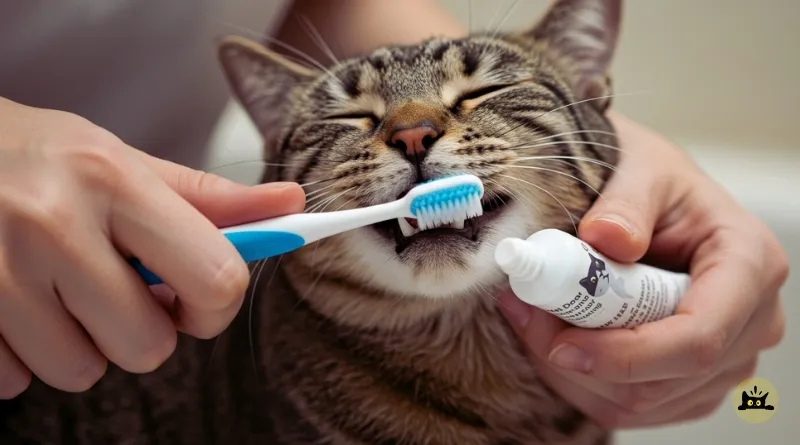While you’re sharing a sweet moment with your furry friend, a sudden bad odor can ruin the whole vibe. Your cat’s bad breath isn’t just a simple hygiene issue; sometimes, it’s a sign of serious health problems. The good news is, there’s an effective way to solve this problem: you must learn to clean cat teeth. This simple habit is one of the most important steps you can take to protect your cat’s overall health. If you’re wondering how to clean cat teeth safely, this guide will show you why it is so important to clean cat teeth and how to do it right.
In this article, you’ll learn step-by-step why your cat’s oral health is so important and how you can easily handle teeth cleaning at home. Remember: a healthy mouth means a happy cat. This guide will give you all the information and confidence you need to start a dental care routine.
The Serious Reasons Behind Bad Breath
Bad breath in cats is an important symptom that often gets ignored. The most common problem underlying this odor is bacterial plaque buildup on the teeth. Over time, this plaque hardens and turns into tartar. Tartar irritates the gums and leads to inflammation. This condition is called gingivitis, and if left untreated, it can turn into a much more serious problem.
In advanced cases, the infection spreads below the gum line and to the bone that supports the teeth. This stage is known as periodontal disease. Periodontal disease not only causes tooth loss and severe pain but can also allow bacteria from the mouth to enter the bloodstream, damaging vital organs like the heart, liver, and kidneys. For this reason, the practice to clean cat teeth isn’t just a cosmetic concern it’s a vital health measure.
Visible Signs of Oral Health Problems
Your cat can’t tell you their teeth hurt, but certain behaviors and physical signs can give you clues. If you notice even one of the following symptoms, your cat may have an oral or dental health issue:
- Persistent Bad Breath: This is the most common and first-noticed sign.
- Yellow or Brown Tartar: Hard buildup seen on the teeth, especially near the gum line.
- Red, Swollen, or Bleeding Gums: Healthy gums are a pale pink color. Redness is a sign of inflammation.
- Excessive Drooling: Saliva production may increase due to discomfort or pain in the mouth.
- Difficulty Eating: Your cat might struggle to chew its food, chew on only one side, or refuse to eat dry kibble.
- Pawing or Rubbing at the Mouth: Constantly touching the mouth area with a paw is a sign of pain or discomfort.
Noticing these signs early helps solve the problem before it gets worse. Establishing a regular routine to clean cat teeth can prevent many of these symptoms from appearing in the first place.
A Guide to Successfully Cleaning Your Cat’s Teeth at Home
The thought of brushing your cat’s teeth might seem intimidating at first, but with the right approach and patience, it can become a manageable routine for both of you. Keeping the process positive and stress-free is essential for a successful experience when you clean cat teeth.
The Right Supplies and Preparation
Starting with the right equipment is half the battle. Here’s what you’ll need:
- Cat Toothpaste: Never use human toothpaste. The fluoride and xylitol in human pastes are highly toxic to cats. Opt for enzymatic toothpastes made specifically for cats, which are often chicken or fish flavored. These pastes help reduce plaque formation.
- Cat Toothbrush: Choose a toothbrush with a small head and soft bristles that fits your cat’s mouth structure. Alternatively, silicone brushes that fit over your finger can be a good option for beginners.
The preparation phase is just as important as the brushing itself. Introduce your cat to this new experience slowly. For the first few days, just let them lick the toothpaste off your finger. Then, gently touch their gums and teeth with your finger to get them used to the contact. Not rushing these steps will help your cat build trust in the process. This prep work is critically important to effectively clean cat teeth.
Step-by-Step Brushing Technique
Once your cat is used to the supplies and your touch, you can move on to brushing.
- Choose a Calm Environment: Pick a time when your cat is relaxed and calm. Hold them in your lap or place them somewhere they can sit comfortably.
- Apply a Small Amount of Paste: Squeeze a pea-sized amount of toothpaste onto the brush.
- Start Gently: Gently lift your cat’s lip and place the brush against the gum line at a 45-degree angle.
- Use Circular Motions: Start by brushing just a few teeth with small, gentle circular motions. Focus especially on the outer surfaces, as this is where tartar accumulates most.
- Keep it Short and Positive: Don’t let the first few sessions last longer than 30 seconds. The goal is to complete the process without overwhelming your cat. Praise them lavishly at the end of each successful session and offer a treat.
It would be great if you could do this routine once a day, but even a few times a week is much better than not at all. Remember, consistency is the most important part when you clean cat teeth. This simple care can reduce the number of expensive and stressful visits to your veterinarian. Understanding the importance of professional care and the need to regularly clean cat teeth at home will help your cat live a long and healthy life. Remember, the habit to clean cat teeth is one of the most tangible expressions of your love.
Sources: ASPCA Animal Poison Control Center, PetMD
You might also like another post in this category: Help Your Cat’s Skin Problems Now

